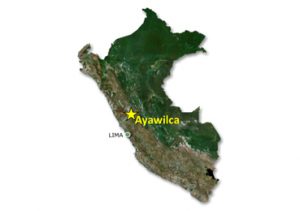![]() Tinka Resources Ltd. {TSX.V: TK}
Tinka Resources Ltd. {TSX.V: TK}
Released assay results for three recent drill holes at the company’s 100-per-cent-owned Ayawilca project in Peru.
Results included 1.7m of 14.5%Zn, 1,130 g/t Ag.
.
.
.

Map of Peru showing the location of Ayawilca.
,
,
,
Tinka drills 1.7m of 14.5%Zn, 1,130 g/t Ag at Ayawilca
2019-10-08 04:09 ET – News Release
Dr. Graham Carman reports
TINKA INTERSECTS EXCEPTIONAL ZINC GRADES AT AYAWILCA AND EXPANDS SILVER ZONE DISCOVERY
Tinka Resources Ltd. has released assay results for three recent drill holes at the company’s 100-per-cent-owned Ayawilca project in Peru.
,
Hole A19-165 has returned some of the best zinc intersections ever drilled at South Ayawilca, both from within and immediately outside of the zinc resource boundary. The hole intercepted four separate, gently dipping mineralised zones with downhole thicknesses of between nine and 29 metres and grading between 11.8 per cent and 14.0 per cent zinc, within a cumulative downhole interval of 170 metres (note: downhole thicknesses approximate true thicknesses in this hole). A summary of the assays from the four intervals in hole A19-165 is provided below.
,
Hole A19-167, a recently completed and deepened 2017 drill hole, intersected very high-grade silver mineralisation (greater than 1,000 grams per tonne silver) accompanied by base metals (14.5 per cent zinc, 0.3 per cent lead) over a narrow 1.7-metre interval approximately 100 metres beneath the existing zinc zone resource, within a wider zone of lower-grade silver mineralisation associated with strongly altered Pucara limestone. The silver intersection in hole A19-167 lies 80 metres from the silver intersection in hole A19-163 (13.9 metres at 130 g/t Ag; see Sept. 5, 2019, news release). This new silver zone discovery supports Tinka’s view that Ayawilca still has significant exploration potential, including upside for precious metals.
.
Key highlights from recent drill holes at South Ayawilca:
Zinc zone
Hole A19-165:
- 9.0 metres at 11.9 per cent zinc and 18 g/t silver from 117.2 metres;
- 25.9 metres at 11.8 per cent zinc, 0.2 per cent lead, 23 g/t silver and 325 g/t indium from 167.8 metres, including:
- 4.0 metres at 24.6 per cent zinc, 33 g/t silver, 0.1 per cent lead and 475 g/t indium from 169.1 metres;
- 7.0 metres at 18.9 per cent zinc, 42 g/t silver, 0.5 per cent lead and 584 g/t indium from 178.4 metres;
- 28.7 metres at 14.0 per cent zinc, 14 g/t silver, 0.1 per cent lead and 101 g/t indium from 214.6 metres, including:
- 18.65 metres at 17.4 per cent zinc, 11 g/t silver and 68 g/t indium from 221.5 metres;
- 14.9 metres at 12.3 per cent zinc, 38 g/t silver, 0.6 per cent lead and 297 g/t indium from 271.5 metres, including:
- 1.2 metres at 36.6 per cent zinc, 80 g/t silver, 0.2 per cent lead and 1,020 g/t indium from 278.6 metres;
- 0.95 metre at 44.1 per cent zinc, 90 g/t silver, 0.3 per cent lead and 867 g/t indium from 285.45 metres.
Hole A19-166:
- 0.8 metre at 38.5 per cent zinc, 117 g/t silver, and 0.4 per cent lead and 442 g/t indium from 122.3 metres;
- 0.85 metre at 31.1 per cent zinc, 40 g/t silver and 311 g/t indium from 138.7 metres.
Silver zone
Hole A19-167 (extension of drill hole A17-064 from 361 metres depth):
- 7.3 metres at 4.9 per cent zinc, 366 g/t silver and 0.5 per cent lead from 412.7 metres, including:
- 1.7 metres at 14.5 per cent zinc, 1,130 g/t silver and 0.3 per cent lead from 412.7 metres;
- 7.85 metres at 6.1 per cent zinc, 150 g/t silver and 0.8 per cent lead from 434.45 metres, including:
- 0.9 metre at 21.7 per cent zinc, 415 g/t silver and 3.0 per cent lead from 434.5 metres.
Note
True thicknesses of the zinc zone intersections are estimated to be approximately equal to the downhole thicknesses in hole A19-165 and at least 85 per cent of the downhole thicknesses in A19-166. The true thickness of the silver zone intersections in A19-167 cannot be determined at this time as insufficient data are available.
,
Dr. Graham Carman, Tinka’s president and chief executive officer, stated: “Hole A19-165 is an exceptional drill hole with four separate mineralised intervals with outstanding zinc grades over significant thicknesses, confirming continuity of the mineralisation and increasing confidence in our geological model. Zinc grades in the upper two zones were higher than predicted by the resource model. Multiple phases of zinc mineralisation, as indicated by spectacular colour banding of the sphalerite crystals, indicate that the mineralisation at Ayawilca was multiphase while also highlighting the fact that each phase added to the zinc grade of the deposit.
“We are also excited by the high-grade silver zone discovery in hole A19-167, originally a 2017 Tinka drill hole that was recently deepened to test extensions of the silver mineralisation encountered in hole A19-163. The success of A19-167 proves that Ayawilca has very high-grade silver mineralisation which is believed to have developed around the edge of the Ayawilca zinc zone. This recent discovery offers a new exploration target and potentially significant precious metal upside to supplement the very large zinc resource.
“The 2019 drill program at South Ayawilca is greatly improving our understanding of the structural and lithological controls of the high-grade zinc mineralisation. Drill hole A19-166 was drilled at a very shallow angle and confirmed the geometry of a locally overturned anticline which has acted as a structural trap for the zinc mineralisation. An additional drill hole, A19-168, was recently collared, which will act as an additional infill hole and provide further geotechnical information.”
.
SUMMARY OF NEW DRILL HOLE ASSAYS FROM AYAWILCA
Drill hole From To Interval Zn Pb Ag In
(m) (m) (m) (%) (%) (ppm) (ppm)
A19-165 117.20 126.20 9.00 11.9 0.0 18 40
incl. 125.10 126.20 1.10 37.2 0.0 36 136
and 167.80 193.70 25.90 11.8 0.2 23 325
incl. 169.10 173.10 4.00 24.6 0.1 33 475
incl. 178.40 185.40 7.00 18.9 0.5 42 584
and 214.60 243.30 28.70 14.0 0.1 14 101
incl. 221.50 240.15 18.65 17.4 0.0 11 68
and 271.50 286.40 14.90 12.3 0.6 38 297
incl. 278.60 279.80 1.20 36.6 0.2 80 1,020
incl. 285.45 286.40 0.95 44.1 0.3 90 867
A19-166 122.30 123.10 0.80 38.5 0.4 117 442
and 138.70 139.55 0.85 31.1 0.0 40 311
A19-167 384.50 388.00 3.50 2.8 0.5 222 0
and 412.70 420.00 7.30 4.9 0.5 366 0
incl. 412.70 414.40* 1.70 14.5 0.3 1,130 0
and 434.45 442.30 7.85 6.1 0.8 150 0
incl. 434.45 435.35 0.90 21.7 3.0 415 2
Note
True thicknesses of the zinc intersections in
hole A19-165 are estimated to be approximately equal to
the downhole thicknesses, and at least 85 per cent of the downhole
thicknesses in hole A19-166. The true thicknesses of the
intersections in hole A19-167 cannot be determined at
this time as insufficient data are available.
.
Notes on sampling and assaying
Drill holes are diamond HQ- or NQ-size core holes with recoveries generally above 80 per cent and often close to 100 per cent. The drill core is marked up, logged and photographed on site. The cores are cut in half at the company’s core storage facility, with half cores stored as a future reference. Half core is bagged on average over one- to two-metre composite intervals and sent to ALS Laboratories in Lima for assay in batches. Standards and blanks are inserted into each batch prior to departure from Tinka’s core storage facilities. At the laboratory samples are dried, crushed to 100 per cent passing two millimetres, then 500 grams pulverized for multielement analysis by ICP using multiacid digestion. Samples assaying over 1 per cent zinc, lead, or copper and over 100 g/t silver are reassayed using precise ore-grade AAS techniques.
.
Qualified person
Dr. Carman reviewed, verified and compiled the technical contents of this release. Dr. Carman is a fellow of the Australasian Institute of Mining and Metallurgy, and is a qualified person as defined by National Instrument 43-101.











